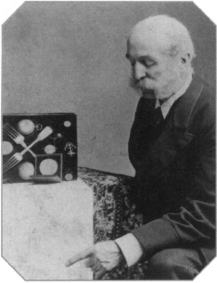
As Rae slogged past Pelly Bay on his way to discovering the Northwest Passage, he met an Inuit wearing a gold cap band. The Inuit said that the band came from a dead kabloona, and that he had traded with other Inuit for it. It was not much information to go on, but Rae told the Inuit that he would buy any other relics if they were brought to his camp at Repulse Bay.
After 56 days of gruelling travel, Rae arrived back at Repulse Bay on May 26, 1854. There he found several Pelly Bay Inuit eager to trade and tell stories. Rae bought all the relics he could and wrote down all the stories—they were horrific. Four winters before, to the west, some Inuit hunters had met a group of forty starving kabloonas dragging a boat over the ice. The kabloonas were led by a tall man with a telescope, and they had traded for some seal meat before continuing on their journey.

An older Rae shows the evidence he found of the expedition
The following spring, the Inuit discovered a camp of tents and an overturned boat. In the tents and beneath the boat were the frozen bodies of at least thirty men. On a nearby island were five more bodies. One of them was of a large man who had a telescope strapped to his back.
With mounting horror, Rae realized that he was hearing about the tragic end of the greatest Arctic expedition ever launched. He now knew what had happened to Sir John Franklin and his men.
Rae collected a wide variety of relics from the Inuit and brought them back to Britain. They included: broken pieces of guns, watches, compasses and telescopes; a gold watch, a medal, spoons and forks belonging to Franklin and several of his officers; and a silver plate engraved “Sir John Franklin, K.C.H.” These, and other sad mementos of tragedy collected by later searchers, are displayed today in museums around Britain.